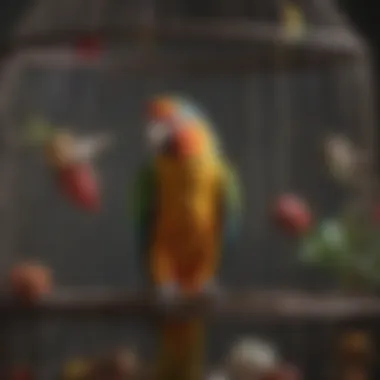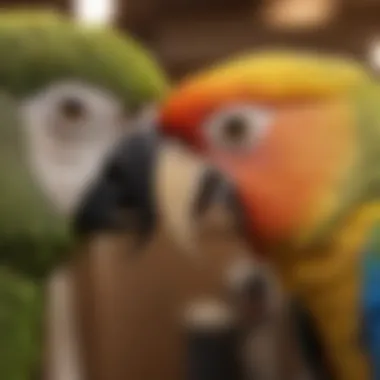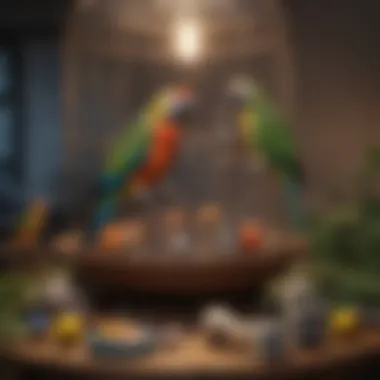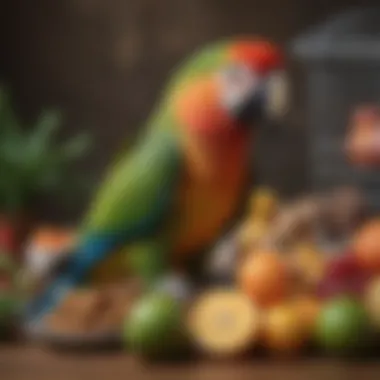Understanding Parrot Ownership Dynamics


Intro
The journey into parrot ownership is a compelling one, full of unexpected turns and rewarding moments. From the vibrant colors and lively squawks to the deep bonds formed over time, having a parrot as a pet can be unlike any other experience. With this article, we aim to shed light on the many facets of caring for these intelligent creatures, diving into the responsibilities and joys that come with being a parrot parent.
By understanding the nuances of parrot behavior, habitat needs, and emotional wellbeing, current and aspiring owners will be better equipped to create a nurturing environment. After all, knowing how to meet essential needs is crucial for fostering a happy and healthy bird.
So, let’s take a closer step into the world of avian care, starting with the basics.
Avian Care Basics
Caring for a parrot involves more than just feeding and providing space. It requires a dedicated approach to understanding their unique needs, starting with proper nutrition.
Importance of Proper Nutrition
Feeding your parrot the right diet is vital for their overall health. A well-balanced diet typically consists of pellets, vegetables, fruits, and occasional seeds. Pellets are often recommended as the foundation of their diet, as they contain necessary vitamins and minerals. However, parrots are not one-size-fits-all, and preferences can vary widely among species.
It’s important to experiment with different foods to see what your bird enjoys. For instance, while cockatiels may munch on corn, an African Grey might prefer broccoli.
"Understanding what fuels your parrot is key to avoiding malnourishment and ensuring longevity."
Understanding Bird Species and Their Needs
Each parrot species has its specific needs and behaviors that owners must learn. For example, while larger parrots, like Macaws, may require more space and stimulation, smaller breeds, such as Budgerigars, can thrive in smaller environments. Comprehending your bird's natural behavior helps to tailor their care and setup to fit their lifestyle.
Being mindful of their natural instincts, like the need to chew and forage, can promote their happiness.
Basics of Birds Habitat Setup
Setting up a proper habitat is crucial. A well-structured cage should be spacious enough for movement, with an assortment of perches and toys to keep your parrot engaged. Remember to avoid placing their cage in drafts or direct sunlight, as both can lead to stress or health issues.
Some key components to consider:
- Perches: Vary the size and texture to strengthen foot muscles.
- Toys: Regularly rotate toys to prevent boredom.
- Cage Location: Keep it social yet secure, away from hazards.
Grooming and Hygiene Tips
While cleaning feathers and clipping nails may seem daunting, establishing a regular grooming routine is crucial. Not only does it maintain your bird’s physical appearance, but it also offers a bonding opportunity. A gentle touch goes a long way in making the experience less stressful for both parrot and owner.
Common grooming practices include:
- Regular Baths: Offer them a shallow pool or misting with water.
- Nail Clipping: Use specialized clippers, ensuring you don’t clip too far.
- Beak Maintenance: Provide wood toys to help them naturally file down their beaks.
By ensuring your parrot receives the right care and attention, you’ll pave the way for a fulfilling companionship that can last for decades to come.


Understanding the Parrot-Care Relationship
Parrot ownership is more than feeding a pet or keeping it in a cage; it embodies a profound connection that intertwines the lives of both the owner and the bird. Understanding the parrot-care relationship is crucial to fostering a rewarding experience, full of personal growth and mutual enrichment. The dynamics of this bond reflect on various levels, including emotional support, companionship, and shared communication. Essentially, it boils down to recognizing that parrots are intelligent, emotional beings that require as much thoughtful care as any other member of the family.
The essence of bonding with a parrot goes beyond mere ownership; it signifies a commitment to nurturing a relationship that can blossom over time. As parrots become more accustomed to their environment, owners also learn the unique personality traits, quirks, and preferences of their feathered companions. This learning process cultivates a relationship grounded in mutual respect and understanding, which can be incredibly fulfilling.
When we delve deeper into the consideration of parrot-care, we unveil a spectrum of responsibilities that an owner must embrace. Providing proper nutrition, creating an engaging habitat, and ensuring personal interactions are just the tip of the iceberg. By actively participating in these aspects, owners not only support the well-being of their parrots but also enrich their own lives through the joy that these vibrant animals bring.
"A parrot's affection is not given lightly; it must be earned through patience and understanding."
Furthermore, recognizing the individuality of each parrot is key to harmonizing the bond. Just like humans, each bird carries its own set of instincts, behaviors, and preferences shaped by its upbringing and personal experiences. As an owner, this calls for a nuanced understanding of one’s parrot, adopting approaches that resonate with its unique character.
The Essence of Bonding
Bonding with a parrot is a journey filled with moments that may very well reshape one’s perspective on pet ownership. From that first tentative nibble on a finger to the delightful chatter that can fill the air when interaction is welcomed, the process of building a close-knit relationship is layered and nuanced. It can involve days filled with patience, listening, and understanding as the bird learns to trust its human counterpart.
One aspect of this bonding is engagement through play and socialization. Regular interaction, whether through gentle talking or play with toys, encourages a parrot to feel secure and appreciated. The bond can be further strengthened by developing a routine that provides predictability in the parrot's life, creating an environment where it feels safe to express itself.
Additionally, observing the bird’s body language provides invaluable insights into its emotional state, enhancing the bond. Recognizing when a parrot fluffs up in delight or when it seems agitated can significantly alter interactions, developing a deeper understanding that speaks volumes without uttering a single word.
Defining the Owner's Role
As a parrot owner, understanding one’s role encompasses much more than enjoying the companionship of a colorful creature. Multiple responsibilities hinge upon the owner, which shape the overall dynamic of the relationship. The first aspect is being an active participant in the bird's daily life. This role often translates into the provision of food, environmental enrichment, and emotional support which, in turn, enhances the bird’s quality of life.
Creating an atmosphere filled with stimulation—through toys, outdoor time, or even simple conversations—incites curiosity and natural behaviors in parrots. It’s essential for owners to ensure that they don’t just care for their birds physically, but also cater to their psychological needs. This dimension of parrot care underscores the importance of being attentive and responsive to emotional cues.
Moreover, education is paramount. Owners should arm themselves with knowledge regarding parrot behavior, dietary needs, and health indicators. Understanding the unique needs of one’s specific breed can dramatically influence the well-being of the parrot. Furthermore, actively seeking out communities, forums, and even scientific studies can serve as valuable resources in gaining insights into the intricacies of parrot ownership.
Thus, being a parrot owner is not a passive endeavor; it demands active involvement, education, and a compassionately attentive stance toward the shimmering soul that shares your world.
Creating the Ideal Habitat
Creating a suitable habitat is pivotal for the well-being of a parrot. These intelligent birds thrive in environments that cater to their physical and psychological needs. A well-thought-out habitat not only ensures comfort but also encourages natural behaviors, which can significantly enhance an owner-parrot bond.
Selecting the Right Cage
Choosing the right cage is like picking a home, but for your feathered friend. A cage should be spacious enough to allow for movement and wing-flapping; after all, parrots are not fans of cramped spaces. The ideal width should be at least twice the wingspan of the bird when fully extended. For instance, if you’re raising a cockatoo, a cage width of 36 inches or more is advisable.
Materials matter too. Look for cages made from non-toxic metal; stainless steel is usually a safe bet. Avoid cages with painted or coated surfaces that might be harmful if chewed.
You might also want to consider the cage design. An aviary-style cage offers more space and allows for various perches and toys, letting your parrot engage fully with its surroundings. Proper bar spacing is crucial; too wide, and your parrot could escape; too narrow, and it could get stuck.
Cage Placement and Environment
Where you place the cage is just as important as the cage itself. Parrots are social creatures, so putting the cage in a busy area of the home allows for interaction with family members. However, avoid direct sunlight, drafts, or extreme humidity.


Consider a corner space that provides a sense of security while still being part of the household activities. Keeping the cage away from heavy foot traffic can also help prevent stress.
In terms of environment, creating a stimulating atmosphere is vital. Adding natural light, although not too intense, can really uplift the spirits of your parrot. It’s also a good idea to incorporate safe plants around the cage - just make sure they’re non-toxic. Ensuring a variety of sounds and sights can help mimic their natural habitat, making them more comfortable and happy.
Essential Accessories for Comfort
Accessories can transform a basic cage into a welcoming home for your parrot. These items encourage activity and provide mental stimulation. First off, different types of perches are essential. Varying the sizes and textures of perches helps keep your parrot’s feet healthy. Wood perches are popular, and you could also add natural branches, which can be sourced from non-toxic trees like apple or willow.
Toys are another crucial element. Parrots are incredibly intelligent and require mental tasks. Interactive toys, like those that dispense treats, can keep them entertained for hours. Ropes, mirrors, and foraging toys stimulate their natural behaviors and prevent boredom.
Food and water dishes should be sturdy and easily cleanable. Change water daily to maintain freshness. Moreover, consider a cozy place within the cage where they can snuggle, like a woven hut or a natural fiber nest.
"Creating the right habitat can mean the difference between a parrot that thrives or one that simply survives. It’s an investment in their happiness and health."
In summary, crafting an ideal habitat is about creating a balanced environment that respects a parrot's nature. By selecting an appropriate cage, positioning it wisely, and equipping it with essential accessories, owners can significantly enhance their avian experience.
Nourishment and Health
In the world of parrot ownership, understanding nourishment and health is not just an afterthought; it’s a cornerstone of creating a vibrant life with your feathered companion. Parrots, being intelligent and sensitive creatures, require a diet that mirrors their natural habits. The health of your parrot is directly linked to what goes into its beak. Serving up a balanced diet establishes a strong foundation for a long, healthy life paired with your avian friend. Moreover, being attuned to their behaviors leads to valuable insights that can aid in spotting health issues early.
Balanced Diet Essentials
A parrot's diet needs to be as colorful as its plumage. This is not merely aesthetics; the hues in fruits and vegetables often represent their nutrient profile. High-quality pellets formulated specifically for parrots are vital, but these should be complemented by fresh produce. Here’s a breakdown of necessary dietary components:
- Feed Quality Pellets: Pellets should comprise about 60-70% of a parrot's diet. It’s essential to choose those without added sugars or fillers.
- Fruits and Veggies: Fresh produce like spinach, carrots, and apples are great choices. Always wash them thoroughly to reduce pesticide residue.
- Seeds and Nuts: These are tasty, but moderation is key. They are high in fat and shouldn’t dominate the diet.
- Protein Sources: Providing occasional boiled eggs or legumes can round out nutritional needs.
Remember, introducing new foods gradually will help to avoid stomach upsets. Just like humans can be picky eaters, so can parrots.
Understanding Parrot Behavior and Health
An integral aspect of being a parrot owner is recognizing how diet impacts behavior and overall health. For instance, a bird that seems lethargic or irritable might be due to malnutrition. Certain behaviors can also signal health issues that require attention. Awareness of these interactions can lead to proactive care. Some signs to be mindful of include:
- Feather Plucking: Often linked to stress or dietary deficiencies.
- Vocalization Changes: An increase or decrease in vocal sounds can indicate distress or health problems.
- Weight Fluctuations: Regularly check your parrot’s weight. Significant changes often suggest underlying issues.
Additionally, engaging with your parrot can bring out behavioral changes. A happy parrot typically exhibits a playful disposition, which is often tied to proper dietary staples.
Common Health Issues to Watch For
Each parrot species comes with its own set of vulnerabilities, but there are common health issues every owner needs to be aware of. Regular vet check-ups are crucial, but as an owner, being observant is equally important. Keep an eye out for signs that something might not be quite right. Some common issues include:
- Obesity: This can stem from an unbalanced diet rich in seeds and low in fresh produce.
- Respiratory Problems: Often exacerbated by dust, pesticides, and poor air quality.
- Psittacosis: A bacterial infection common in parrots; symptoms include lethargy and respiratory distress.
- Nutritional Deficiencies: Striking the right balance in nutrients can help prevent diseases like MBD, which can occur from calcium deficiency.
“A well-fed parrot is often a happy parrot. Their health reflects their nutrition.”


Staying observant to your parrot’s eating habits, along with a proper diet, will ensure they stay active and engaged, making life with them both rewarding and enjoyable.
Training and Socialization
Training and socialization are not just tasks but critical aspects of parrot ownership that enhance the partnership between you and your avian friend. These processes fundamentally shape a parrot’s behavior and interaction style, impacting not just their happiness but also their adaptability to diverse environments. It’s about building a bridge of trust and communication, ensuring that both you and your parrot navigate life together, hand in wing.
Positive Reinforcement Techniques
When it comes to teaching a parrot new tricks or behaviors, positive reinforcement is a tried-and-true method that works wonders. This technique involves rewarding desired behaviors, making it more likely those actions will be repeated. For instance, if your parrot spins around on command and you immediately give them a treat or a scratch behind the ears, they’ll soon understand that spinning gets them good stuff.
- Consistency is key. Each time the behavior is displayed, the reward must follow promptly. This reinforces the link between action and reward.
- Using varied rewards can keep the training exciting. Sometimes you can use treats, while other times, your parrot may appreciate praise or their favorite toy.
- Be certain to patience is central here; parrots, like humans, have their off days and may need extra encouragement along the way.
Employing positive reinforcement not only teaches skills but also strengthens the emotional bond shared between you and your feathered companion.
Developing a Routine
Establishing a daily routine is essential for parrot well-being, just like how kids thrive on structure. Parrots are intelligent creatures that thrive when they know what to expect. By creating a consistent schedule for feeding, training, and playtime, you foster an environment where your parrot feels secure and supported.
- Morning training sessions might be beneficial when your parrot is most alert and eager to engage. Consider reserving this time for essential skill-building or learning new tricks.
- Regular playtime helps to keep your parrot mentally stimulated and physically active, so finding time for this is vital. This could be when you unwind after work; it’s a welcome joy for both you and your bird.
- Additionally, interspersing treats or enrichment activities within the routine encourages spontaneity, which keeps the daily interactions fresh and fun.
A predictable routine can significantly reduce stress for your parrot, helping them develop confidence while reinforcing the bond you share.
Recognizing Unique Personalities
Every parrot has a distinct personality, much like people. Understanding and embracing those quirks is fundamental in fostering a strong relationship. For instance, some may be curious and outgoing, while others could be a bit shy or more reserved.
- Observe body language. A parrot flapping its wings or hopping about might be excited or anxious, whereas a calm stance might indicate comfort. Knowing the signs helps gauge their mood.
- Tailoring training methods to fit their personality enhances effectiveness. An anxious parrot might need gentle encouragement rather than aggressive tactics, while an outgoing one could thrive in a more engaging environment with various activities.
- Encourage self-expression. Offering toys that challenge their intelligence can reveal hidden talents and help you discover the unique personalities of your feathered friends.
Recognizing and respecting your parrot's individuality not only paves the way for effective training but also creates an enriching environment where both of you can grow, learn, and even laugh together.
Emotional Considerations in Parrot Care
Caring for a parrot is more than just feeding it or providing water; it's also about understanding the emotional landscape that comes with sharing your life with an intelligent creature. Emotions play a huge role in how both the owner and bird interact. Parrots, being social animals, thrive on connection and can experience a wide range of feelings like joy, fear, excitement, and even loneliness. Therefore, recognizing and addressing these emotional needs is crucial for a harmonious relationship.
Understanding Your Parrot’s Needs
Each parrot brings its own personality and quirks to your home. Some might be more talkative or playful, while others could exhibit shy, reserved behaviour. It’s vital to take the time to observe these characteristics and adapt to them. Understanding your parrot’s needs involves being attuned to its behavioral cues. For instance, when a parrot fluffs up its feathers, it might be feeling comfortable and safe, while a bird that hides may require some extra reassurance.
Moreover, consistent interaction is key. Schedule daily bonding time, even if it’s just a few minutes. This could be simple things such as talking to your parrot or allowing it to perch on your shoulder while you go about your day. Not giving enough attention can lead to feelings of neglect, which can manifest in destructive behaviors or vocalizations. A parrot needs to feel loved and secure; otherwise, its emotional health suffers.
Fostering Emotional Connection
Creating a deep emotional bond with your parrot involves activities that reinforce trust and affection. One effective way is through playtime. Parrots enjoy interacting with toys, and this can also serve as a medium for building connection. Engaging them in games or puzzles encourages mental stimulation and helps build a bond based on shared experiences.
Another essential aspect of fostering connection is communication. Parrots are excellent mimickers, and often they will repeat words or phrases they hear frequently. Use this to your advantage by teaching your parrot words that convey your feelings, such as "hello" or "I love you". This not only excites the bird but also signals that you are present and interacting with it, enhancing its emotional well-being.
- Key ways to foster emotional connection:
- Engage in daily play sessions.
- Communicate regularly and use simple phrases.
- Provide a varied diet to promote happiness and health.















